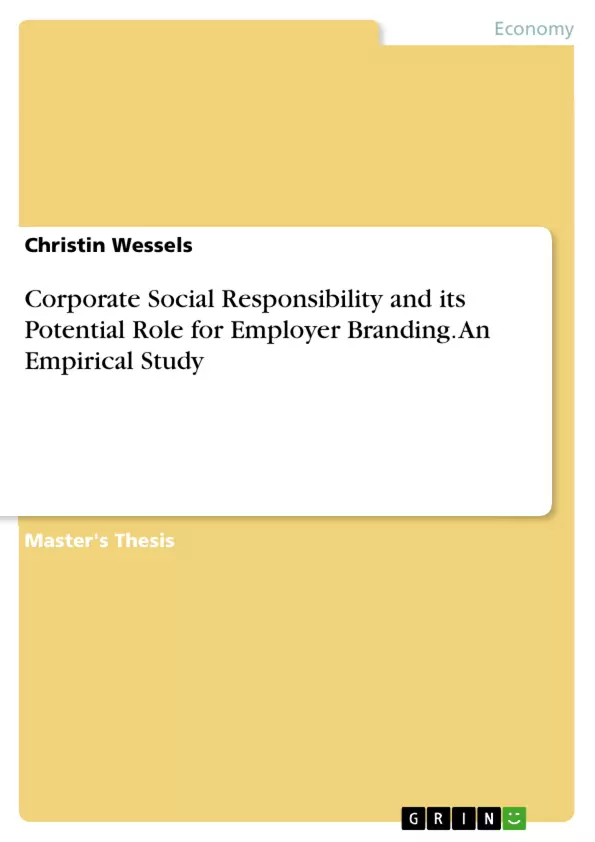Human capital becomes more and more important for enterprises and actions have to be taken to become employer of choice for potential candidates. This can happen as a result of an employer brand transmitting a positive image of a themselves to potential candidates. At the same time, Corporate Social Responsibility can have on impact on motivating, retaining and finding employees. The present master the-sis combines these two aspects with the intention to find establish which role CSR plays in employer branding. Based on a literature review and current research, a survey was developed. Criteria defining CSR was determined before an online survey including these aspects was published.
Inhaltsverzeichnis (Table of Contents)
- 1. Introduction
- 1.1 Problem Description
- 1.2 Aim of the Thesis
- 1.3 Thesis Design
- 2. Background and Theory - CSR
- 2.1 Defining CSR
- 2.2 CSR and Sustainable Development
- 2.3 CSR in Enterprises
- 2.3.1 Reasons for CSR in Enterprises
- 2.3.2 Integrating CSR in Enterprises
- 2.3.3 Factors of Success
- 3. Employer Branding
- 3.1 Defining Employer Brand
- 3.1.1 The Employer Brand as Part of the Corporate Brand
- 3.1.2 Employer Brand's Functions
- 3.2 Representing the Employer Brand: Employer Branding
- 3.2.1 Employer Branding versus Human Resource Marketing
- 3.2.2 Objectives of Employer Branding
- 3.2.3 Process of Employer Branding
- 3.2.4 Factors of Success
- 4. CSR and Employer Branding
- 4.1 Current Research
- 4.1.1 Role of CSR to Attract and Retain Employees
- 4.1.2 Role of HR in CSR
- 4.2 Sustainable Brand as Connection of Employer Brand and CSR
- 5. Interim Conclusion: Research Question and Aim of the Study
- 6. Methodology
- 6.1 Defining and Operationalising CSR Aspects
- 6.1.1 Analysing International Standards to Define CSR Aspects
- 6.1.2 The ERG-Theory as Basis for Ranking
- 6.2 The Questionnaire as Research Method
- 6.2.1 Target Group and Sample Size
- 6.2.2 Questionnaire Design
- 6.2.3 Pretest
- 7. Empirical Results
- 7.1 Demographic Characteristics of Respondents
- 7.2 Results Analysed by Category
- 7.3 Results Analysed by Age Group
- 7.4 Results Analysed by Work Experience
- 7.5 Results Analysed by Gender
- 7.6 Results Analysed by ERG-Theory
- 8. Discussion
- 8.1 Answering the Research Questions
- 8.2 Implications for Employers
- 8.3 Limitations of the Work and Suggestions for Future Research
- 9. Summary
Zielsetzung und Themenschwerpunkte (Objectives and Key Themes)
This master's thesis investigates the connection between Corporate Social Responsibility (CSR) and its potential role in Employer Branding, specifically exploring how CSR impacts an organization's ability to attract and retain talented employees. The study aims to identify the key aspects of CSR that are most influential in shaping an employer's brand image and ultimately contribute to becoming an employer of choice.
- The impact of CSR on employer branding
- The role of CSR in attracting and retaining talent
- The importance of integrating CSR into organizational strategy
- The influence of CSR on employee motivation and engagement
- The connection between CSR and the development of a sustainable brand
Zusammenfassung der Kapitel (Chapter Summaries)
This section will provide a comprehensive overview of the main themes and arguments presented in each chapter, excluding the final chapter or any sections that contain major revelations or spoilers.
- Chapter 1: Introduction This chapter introduces the research topic, outlining the problem description, the thesis aim, and the overall design of the study.
- Chapter 2: Background and Theory - CSR This chapter dives into the theoretical framework of Corporate Social Responsibility (CSR), defining its core concepts, exploring its relationship with sustainable development, and analyzing its implementation within enterprises.
- Chapter 3: Employer Branding This chapter defines and explores the concept of employer branding, examining its role within the corporate brand, its functions, and its impact on attracting and retaining employees.
- Chapter 4: CSR and Employer Branding This chapter delves into the connection between CSR and employer branding, analyzing current research on the role of CSR in attracting and retaining employees. It also discusses the concept of a sustainable brand as an intersection between employer branding and CSR.
- Chapter 5: Interim Conclusion: Research Question and Aim of the Study This chapter concludes the initial theoretical framework, formulating the research question and clarifying the study's objectives.
- Chapter 6: Methodology This chapter outlines the research methodology employed in the study. It details the operationalization of CSR aspects, the use of questionnaires as a research method, and the selection of the target group and sample size.
- Chapter 7: Empirical Results This chapter presents the findings of the empirical study. It analyzes the demographic characteristics of the respondents and presents the results according to various categories, including age, work experience, gender, and the ERG theory.
- Chapter 8: Discussion This chapter discusses the implications of the empirical findings, answering the research questions and highlighting the implications for employers. It also addresses limitations of the study and proposes directions for future research.
Schlüsselwörter (Keywords)
The master's thesis focuses on the connection between Corporate Social Responsibility (CSR), Employer Branding, and their impact on employee attraction and retention. Key concepts include the role of CSR in shaping an employer's brand image, the integration of CSR into organizational strategies, and the influence of CSR on employee motivation, engagement, and satisfaction. The study also examines the concept of a sustainable brand as a combination of employer branding and CSR principles.
- Citar trabajo
- Christin Wessels (Autor), 2018, Corporate Social Responsibility and its Potential Role for Employer Branding. An Empirical Study, Múnich, GRIN Verlag, https://www.grin.com/document/442184



